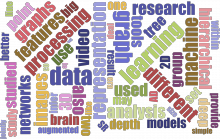MALEGRA - Multimodal Signal Processing and Machine Learning on Graphs

| Type | Start | End |
|---|---|---|
| National | Jan 2017 | Jun 2021 |
| Responsible | URL |
|---|---|
| Javier Ruiz-Hidalgo / Xavier Giró |
Reference
MALEGRA, TEC2016-75976-R, financed by the Spanish Ministerio de Economía, Industria y Competitividad and the European Regional Development Fund (ERDF)
Description
The goal of this project is to study and develop tools combining graph signal representation and processing ideas with machine learning technology. These tools will be used in the context of applications where the size and/or the heterogeneity of the data represent challenges of the Big Data era. The development of technologies related to the capture, storage, search, distribution, transfer, analysis and visualization of ever growing heterogeneous datasets entails tremendous difficulties. At the same time, these difficulties open new opportunities and this development has become a major trend in the field of Information and Communication Technology. The research performed in this project targets applications such as multi-view representations, video analysis, remote sensing for earth monitoring, person identification, health monitoring, medical imaging, genomics, etc.
The project has 4 major objectives. The first two objectives concentrate most of the development of theoretical and basic tools within the project. Within them, we will investigate the creation, analysis, segmentation, filtering and merging of graph structures of heterogeneous multimodal data and on the combination of these ideas with machine learning techniques. This combination with machine learning will be used for several different purposes. In particular, to provide a classification decision, to learn a mapping or a model to be used in a data processing architecture, to learn features that outperform handcrafted equivalents or to aggregate several features to create a signal to be further processed.
The last two objectives of the project focus on the application of the techniques and tools developed in the first two objectives in complex challenges that deal with big and heterogeneous data. In particular, these techniques and tools will be used to study the identification of persons in broadcast TV programs, the optimal encoding of depth maps in multi-view plus depth representations, the radiometric estimation and object detection in SAR and PolSAR images, the classification of multispectral and hyperspectral images, the understanding of brain changes during the evolution of Alzheimers disease, the inference of gene regulatory networks and the segmentation, tracking, indexing and super-resolution of multimodal video sequences.
Publications
|
. Who watches the watchers? Quality control of the human inspection in production lines using Visual Intensity of Attention. In: SAAEI 2018. SAAEI 2018. Barcelona; 2018. |
| . Projection to Latent Spaces Disentangles Specific Cerebral Morphometric Patterns Associated to Aging and Preclinical AD. In: Alzheimer's Association International Conference. Alzheimer's Association International Conference. Chicago, USA; 2018. |
| . Characteristic Brain Volumetric Changes in the AD Preclinical Signature. In: Alzheimer's Association International Conference. Alzheimer's Association International Conference. Chicago, USA; 2018. |
| . Monte-Carlo Sampling applied to Multiple Instance Learning for Whole Slide Image Classification. In: International Conference on Medical Imaging with Deep Learning. International Conference on Medical Imaging with Deep Learning. Amsterdam, The Netherlands; 2018. |
| . Brain MRI Super-Resolution using Generative Adversarial Networks. In: International Conference on Medical Imaging with Deep Learning. International Conference on Medical Imaging with Deep Learning. Amsterdam, The Netherlands; 2018. |
|
. Recurrent Neural Networks for Semantic Instance Segmentation. In: CVPR 2018 DeepVision Workshop. CVPR 2018 DeepVision Workshop. ; 2018. |
|
. Oriented trajectories as a method for audience measurement. In: 27th International Symposium on Industrial Electronics (ISIE). 27th International Symposium on Industrial Electronics (ISIE). Cairns, Australia: IEEE; 2018. |
|
. Temporally Coherent 3D Point Cloud Video Segmentation in Generic Scenes. IEEE Transactions on Image Processing. 2018 ;27(6):3087 - 3099. |
| . Method for upscaling an image and apparatus for upscaling an image. 2018 . |
|
. HybridNet for Depth Estimation and Semantic Segmentation. In: ICASSP 2018. ICASSP 2018. Calgary, Alberta, Canada: IEEE; 2018. |
Pages
Collaborators
| Javier Ruiz Hidalgo | Associate Professor | j.ruiz@upc.edu |
| Xavier Giró | Associate Professor | xavier.giro@upc.edu |
| Ferran Marqués | Professor | ferran.marques@upc.edu |
| Albert Oliveras | Associate Professor | albert@tsc.upc.edu |
| Philippe Salembier | Professor | philippe.salembier@upc.edu |
| Elisa Sayrol | Associate Professor | elisa.sayrol@upc.edu |
| Josep R. Casas | Associate Professor | josep.ramon.casas@upc.edu |
| Veronica Vilaplana | Associate Professor | veronica.vilaplana@upc.edu |
| Montse Pardàs | Professor | montse.pardas@upc.edu |
| Marc Maceira | PhD Candidate | marc.maceira@upc.edu |
| Xiao Lin | PhD Candidate | xiao.lin@upc.edu |
| Alba Pujol | PhD Candidate | alba.pujol@upc.edu |
| Adrià Casamitjana | PhD Candidate | adria.casamitjana@upc.edu |
| Albert Gil Moreno | Software Engineer | albert.gil@upc.edu |
